Fiji, Januari - August 2013
FIJI
JANUARY 2013 - AUGUST 2013
As Xmas approached a group of us decided that it would be nice to give presents to one another but in a rather different way. Each person would contribute a $10 present and dice were thrown so it was an arbitrary selection. We won a unusual present which was to have a professional Italian Chef ( David, a fellow cruiser on the yacht Equinox ) prepare an Italian dinner for us on board Stravaig.
It was a lucky win for us, the dinner was absolutely wonderful!
Xmas day was spent with some friends at the Copra shed yacht club where we had a very nice brunch.
We saw the New Year in at the party at the Copra Shed. Jose and Coby made Dutch oliebollen, a Dutch tradition for New Year’s Eve, which was much appreciated by all the other cruisers.
Bill Shaw on Galena arrived after having experienced hurricane Evan at 120 knots in a far less protected anchorage then we have. He picked up the mooring next to us and settled in.
Hurricane season is quite boring( between storms!!) and our friends on Drifter, Coby and Arnold, decided it was a good opportunity to build a hard top bimini . Having some experience with such things we were happy to give a hand and it proved a great success.
Heinz from Mambo, soon got motivated and built one for his catamaran and Bill, not to be outdone made one for his Westsail 32. The comfort on all three boats was very much improved and they all were very happy with the results.
Heinz and Sylvia met a local Indian man and introduced us to him.
Arvind very soon had us convinced to attend his daughter’s upcoming wedding, which was to be traditional Hindu style.
The bride and groom hardly know each other, their marriage is arranged by their parents.
Prior to the wedding the brides father took Jose and the other invited cruiser ladies shopping for Sari’s in Labasa, the biggest town on the island, a 3 ½ hours away by bus.
Arvind helped the ladies select the fabric and later the ladies of his family helped to create the beautiful outfit’s.
We did need all the help!
The wedding celebrations were conducted over 3 days of ceremonies, dancing and feasting and many more days before to do all the preparations, attended also by Coby, Sue and her Mum and Jose.
Once used to the Sari it is very comfortable to wear. The ladies were invited to come and help with cooking etc, which was a great experience. Eating is done with your hands!
One evening during the wedding celebrations Jose was adopted by a very friendly black and white kitten who sat on her lap for several hours. She made inquiries of the family whether or not it belonged to anybody and finding that it was a stray it ended up with us on the boat.
Within a few days he had established himself as a new crew member! We guessed his age to be about six weeks.
Coby, from Drifter, was very pleased to give us some help with one of our projects which was to make a fitted canvas cover for the dinghy to protect it from the sun. Coby had made several before and proved most helpful.
In the middle of May a local friend introduced us to the trustees of A new Fiji Charity which offers very low price care for Animals. They were very interested to employ us both to start an animal clinic here in Savusavu. Although this a slow and tedious business because of the local rules and regs we have been very much involved in getting things going. Our visa unfortunately expired at the end of May which made it necessary for us to leave Fiji, visit another country before coming back and entering Fiji with a new 4 months visa. We chose to sail to Wallis Island which is French and quite Polynesian.
The weather was fairly rough on our way and we decide to stop first in Futuna, another part of this French territory.
When the weather had improved we continued up to Wallis where we enjoyed a few weeks in a pleasant island which incidentally has its own king.
When we got back to Fiji, we found that the charity had made some progress with our permits and almost immediately they flew Jeff to an island called Malolo Lailai to see a wounded goat which belonged to the islands owner. www.maloloisland.com/
Jeff had first class accommodation at the island resort, dinner and breakfast with the owner and was flown back to Savusavu the following day. The goat proved to have a very good prognosis.
Whilst Jeff was away, Jose and a group of friends attended a traditional Fijian feast called a Lovo where the food is cooked in the ground.
 The view of the bay

Traditional Kava bowl


Kava is used for medicinal, religious, political, cultural and social purposes throughout the Pacific. These cultures have a great respect for the plant and place a high importance on it. In Fiji, for example, a formal yaqona (kava) ceremony will often accompany important social, political, religious, etc. functions, usually involving a ritual presentation of the bundled roots as a sevusevu (gift), and drinking of the yaqona itself.[35]
Correspondingly, the paraphernalia surrounding the traditional kava ceremony are expertly crafted. Traditionally designed kava bowls are made from a single piece of wood, with multiple legs. More modern examples are also highly decorated, often carved and inlaid with mother of pearl and shell.
Kava is used primarily at social gatherings to increase amiability and to relax after work. It has great religious significance, being used to obtain inspiration. Among some Christian denominations and sects in the Western Pacific, the drink has been seen as a vice to some, and some young members of these religions often reject its traditional and nontraditional uses. However, among many mainline Christian denominations, i.e. the Roman Catholic, Methodist, and Anglican churches, kava drinking is encouraged where it replaces alcohol.
2nd from the left is the chief of the village
There is perhaps nothing that captures the essence of Fijian culture better than the ‘sevusevu’. It is the central component of all life-cycle rituals, social gatherings, healing ceremonies and community meetings.
Significant and ancient in Fiji, the “sevusevu” also marks the time and place for visitors (you) to seek acceptance into a Fijian village.
A half kilo bundle of waka is the appropriate (and required – you should never show up in a village without it!) offering, and this should cost you in the region of FJ$25.
When you arrive at a village, you should ask for the ‘Turaga ni Koro’ (pronounced too-ranga nee koro) who is the appointed village headman. It is his duty to greet you and ascertain your intentions before presenting you and your gift to his chiefs and village elder.
Everyone participating in the ceremony should be dressed accordingly in a sulu. Women are also expected to have their shoulders covered and everything should be removed from your head (for example, hat, sunglasses).
A small chant performed by the Turaga ni Koro at the door step of either a house or village hall signals your presence and intention to the people waiting inside. A reciprocal chant from those inside invites you to enter.
You will be shown where to sit on the woven mat (remember to remove your shoes). Men should sit cross-legged (ensuring the sulu covers your knees) while women sit with knees and feet together, resting on the floor to whichever side is most comfortable. Silence at this point is the key.
The Turaga ni Koro will approach the Chief on his knees to place your bundle of yaqona in front of him, staying low as he does so.
He will cobo three times, which in Fijian culture means, “I am about to speak, thank you for listening while I do”.
It is inappropriate to take photographs or video footage throughout the ceremony (the Turaga ni Koro will usually indicate the appropriate time for you to start snapping once all the formalities are out the way).
He will then begin reciting the traditional monologue, which differs slightly throughout Fiji, but essentially means the same thing. This will end with a chant, coupled with three more cobos that indicate they have completed their introduction.
The Chiefs ‘herald’ – or second in command, will officially accept the yaqona on behalf of the chief with three cobos to announce the beginning and end of his speech.
In a formal yaqona ceremony, authority is given by the village spokesman to begin mixing the yaqona. In a ceremonial setting, every movement involving the mixing is significant.
In the old days, the dried roots were cut into small pieces and chewed to soften them, before being added to the tanoa with water.
These days fortunately, chewing has become unnecessary, with the pieces now pounded to a fine powder form before being mixed with water and filtered through a silk cloth, or for more formal situations, through hibiscus fibres.
The man in charge of preparing the kava will cobo and recite the words ‘I will respectfully mix the yaqona for the Chieftain’, in local dialect
When the yaqona has been prepared, and the consistency approved by the chief’s spokesman, the ‘mixer’ puts his hands together and circles the Tanoawith his hands, saying “With respect to the chiefs, yaqona is ready to drink”. Then he cups his hands, cobo three times and begins to serve the yaqona in a Bilo.
This will be carefully taken to the chief in his own, personal bilo. The chief will receive your offering by cupping his hands and clapping with a deep, dignified sound. As he is drinking everyone will clap in slow time, and when he is finished the herald will exclaim “Maca” (which means ‘empty’, and everybody present should cobo three times.
The same will be repeated for the herald, but all will cobo only twice when he is finished. For a time this process will be repeated until the tanoa is empty, at which point the mixer announces “the bowl is empty my chief’, and everyone cobos. The mixer then runs both hands around the bowl and cobos three times which terminates the formal part of the ceremony.
A second tanoa is then prepared from which everyone will drink. A server will carry a bilo to the chief guest (you), who must cobo once before and three times after completely drinking the first cup. The order of serving depends on the status of those present, from the highest-ranking, down (sorry ladies, but women will usually go last in this patriarchal society!).
After the first ‘round’ is complete and everyone has drunk, the ceremony relaxes and the drinking session will continue along with the telling of many stories. You are likely to be asked to introduce yourself and talanoa about your travels.
Remember that this is just a guide, and that kava ceremonies can vary from one village to the next, with each maintaining their own unique features of an ageold tradition.
There is another world of social ‘grog’ drinking among younger people or in more urbanized areas. These sessions will usually see you drinking yaqona out if a brightly coloured plastic tea cup, from a laundry bucket!
 All the baskets are handwoven for the occasion.  Epeli and his wife and children who opened their house for us.  local flowers Another project with which we
are occupied is that we have undertaken to help and advice on the manufacturing and installation of the mooring field for yachts in our immediate part of the Savusavu Marina area in Nakama creek
.
It seems to be going fairly well and we now have 5 moorings that are functional and ten more being made. We hope these will all be ready in good time for the upcoming cyclone season.
The cyclone season incidentally begins officially on November 1st and will end on May 1st 2014.
We will be here again for that time with many of our friends.
Jose went to Labasa the first time with 3 friends, just to explore the " big city "
We always celebrate Burn's Night on Stravaig, this year without the haggis!
A bit of beautiful nature
The local market where we go at least twice a week for our fruit and vegetables. The choice is great and everything is very fresh.
These chair I saw at a friend's place who has got a house here, very special.
And of course some pictures of Tim!
 |









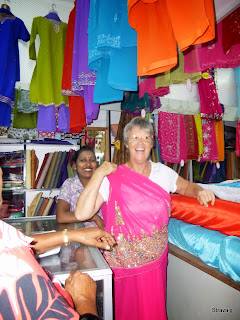





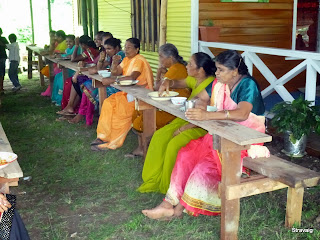




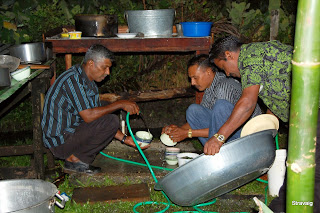



























































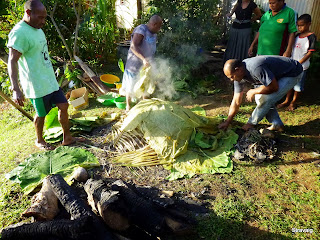

























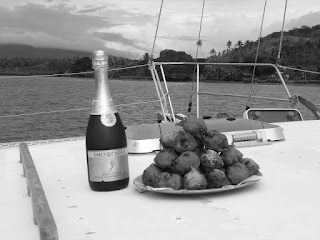
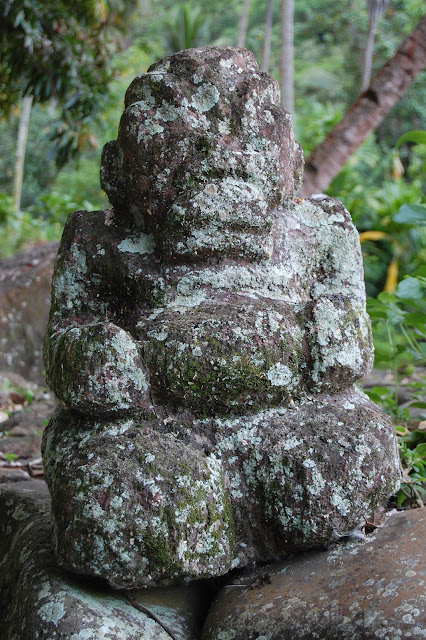
Comments
I enjoyed catching up on your adventures in the South Pacific. It's fun seeing all the pictures of the wonderful places you have visited. I'm headed to Mexico to help Gil on Sunday do the last leg of their trip back to San Diego from Mazitlan. I enjoyed meeting you both in San Diego.
Mark Gumprecht